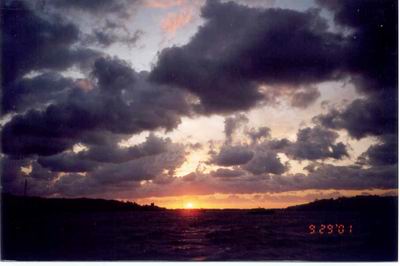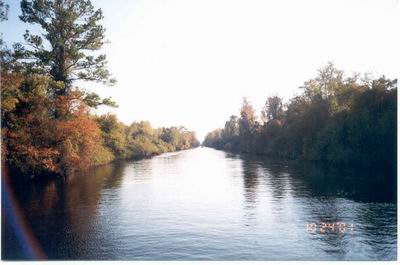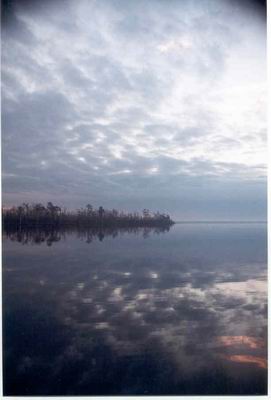Date: 3 November, 2001
Port of Call: Beaufort, North Carolina
Subject: Snowbirds
This year we decided to travel south by following the retreating warm weather, rather than being pushed by the advancing cold weather. It's a small point, but one which makes a big difference in the character of our fourth autumn migration. We are visiting ports about two weeks earlier this year than we have in previous years. We are travelling with the main bulk of the "snowbirds", as boaters who make this migration are often called. Instead of being on our own or meeting the occasional straggler like ourselves, we find that the anchorages are crowded, the VHF radio is noisy, and the waterway is a procession of masts strung out as far as the eye can see, like moving fenceposts in a watery landscape.
Sunset at Cuttyhunk
 Even this early in the season we have found ourselves sitting in harbor waiting
for what seems like more bad weather than usual. In Cuttyhunk, Massachusetts,
we hunkered down for three days while a gale blew over. The commuter
ferry to Block Island was shut down by the weather, something we had never
heard happen before. In Newport, RI we were pinned down for ten days
by a combination of gales in our area and storms well offshore creating seas
too large to travel. The bad weather did bring some good, as it gave
us the time to see my uncle Brad and my nephew Christian, both of whom live
close enough to Newport to come for a visit. Still, when a weather
window good enough to head offshore hadn't appeared after 10 days, we gave
up on our plans for a direct passage to Norfolk, and headed down Long Island
Sound instead.
Even this early in the season we have found ourselves sitting in harbor waiting
for what seems like more bad weather than usual. In Cuttyhunk, Massachusetts,
we hunkered down for three days while a gale blew over. The commuter
ferry to Block Island was shut down by the weather, something we had never
heard happen before. In Newport, RI we were pinned down for ten days
by a combination of gales in our area and storms well offshore creating seas
too large to travel. The bad weather did bring some good, as it gave
us the time to see my uncle Brad and my nephew Christian, both of whom live
close enough to Newport to come for a visit. Still, when a weather
window good enough to head offshore hadn't appeared after 10 days, we gave
up on our plans for a direct passage to Norfolk, and headed down Long Island
Sound instead.We made quick work of the Sound, stopping in the Connecticut River, Port Jefferson, and Oyster Bay. We were surprised by the salt marshes of the Connecticut River, which looked much like the Low Country of coastal Georgia and South Carolina, and which were relatively uncrowded, considering how densely populated it is between New York and Boston.
New York skyline—October 1993 and October 2001
 We stopped in Oyster Bay for an extra day and rode the Long Island Railroad
into New York City, where we joined friends Howie and Lynda, who we first
met cruising the Caribbean in 1999 and 2000. Howie and Lynda had lived
in New York for many years, and they took us on a walking tour from the Empire
State Building all the way down to the former site of the World Trade Center,
or as close as we could get with all the security. All along the perimeter
of the secure area were extemporaneous shrines of flowers, and walls papered
with posters of the missing or letters of support from school children.
Pervading everything was the smell of cinders, like that found near a burned-out
building. Down some of the streets, past barricades and policemen standing
guard, we could see the occasional pile of rubble or the exposed innards
of one or another smaller buildings torn open to our view. Outside
of the immediate area of the disaster the city itself was quiet, without
much automobile traffic and all the honking of horns and roar of engines
that is usual for this enormous city. The next day we motored Sovereign
down the East River and past the stunted skyline of the city. Even
on the river the changes of the city were evident, as Coast Guard vessels
stood watch over the power plant, bridges, and even the Statue of Liberty.
We stopped in Oyster Bay for an extra day and rode the Long Island Railroad
into New York City, where we joined friends Howie and Lynda, who we first
met cruising the Caribbean in 1999 and 2000. Howie and Lynda had lived
in New York for many years, and they took us on a walking tour from the Empire
State Building all the way down to the former site of the World Trade Center,
or as close as we could get with all the security. All along the perimeter
of the secure area were extemporaneous shrines of flowers, and walls papered
with posters of the missing or letters of support from school children.
Pervading everything was the smell of cinders, like that found near a burned-out
building. Down some of the streets, past barricades and policemen standing
guard, we could see the occasional pile of rubble or the exposed innards
of one or another smaller buildings torn open to our view. Outside
of the immediate area of the disaster the city itself was quiet, without
much automobile traffic and all the honking of horns and roar of engines
that is usual for this enormous city. The next day we motored Sovereign
down the East River and past the stunted skyline of the city. Even
on the river the changes of the city were evident, as Coast Guard vessels
stood watch over the power plant, bridges, and even the Statue of Liberty.Sunrise over Assateague
 We waited in Atlantic Highlands, New Jersey, just south of New York City
for a day as a cold front passed overhead and the gale force winds directly
behind it began to subside, then we headed offshore down the New Jersey coast.
The sailing was good: flat seas and a beam reach that tightened into
a close reach as we sailed into the evening. After midnight the wind
went light and we motored on into the night. By the next afternoon
the wind had shifted to the southwest, and we were motoring into a nasty,
short chop. Instead of continuing on to Norfolk, we ducked into Ocean
City, Maryland, behind Assateague Island. There we waited another two
days for a change of weather and then traveled another 24 hours into Hampton,
Virginia.
We waited in Atlantic Highlands, New Jersey, just south of New York City
for a day as a cold front passed overhead and the gale force winds directly
behind it began to subside, then we headed offshore down the New Jersey coast.
The sailing was good: flat seas and a beam reach that tightened into
a close reach as we sailed into the evening. After midnight the wind
went light and we motored on into the night. By the next afternoon
the wind had shifted to the southwest, and we were motoring into a nasty,
short chop. Instead of continuing on to Norfolk, we ducked into Ocean
City, Maryland, behind Assateague Island. There we waited another two
days for a change of weather and then traveled another 24 hours into Hampton,
Virginia.Fall colors in the Dismal Swamp
 In Hampton we met even more of the flock of migrating snowbirds, as early-comers
to the Caribbean 1500 rally mixed with boats embarking upon the Intracoastal
Waterway. It was so crowded that we were not able to anchor in the
downtown Hampton area, and instead had to take a spot out by the mouth of
the river. We passed through Norfolk the next day, with patrol boats
everywhere maintaining the safety zones around the Naval Shipyard and escorting
the incoming aircraft carrier "Coral Sea", and an outbound submarine.
That afternoon we locked through Deep Creek lock and up eight feet into the
Dismal Swamp. We proceeded through the Dismal Swamp Canal in procession
with all the other boats that had locked through with us. Despite the crowds,
the Dismal Swamp was as beautiful as ever. This time we passed during
the peak of the fall foliage, with brightly clad trees close on each bank
of the canal creating a collage of yellows and reds. The gusty winds
freed countless leaves from their branches to whirl around us in a blizzard
of color before coming to rest on the tea-dark waters of the canal.
In Hampton we met even more of the flock of migrating snowbirds, as early-comers
to the Caribbean 1500 rally mixed with boats embarking upon the Intracoastal
Waterway. It was so crowded that we were not able to anchor in the
downtown Hampton area, and instead had to take a spot out by the mouth of
the river. We passed through Norfolk the next day, with patrol boats
everywhere maintaining the safety zones around the Naval Shipyard and escorting
the incoming aircraft carrier "Coral Sea", and an outbound submarine.
That afternoon we locked through Deep Creek lock and up eight feet into the
Dismal Swamp. We proceeded through the Dismal Swamp Canal in procession
with all the other boats that had locked through with us. Despite the crowds,
the Dismal Swamp was as beautiful as ever. This time we passed during
the peak of the fall foliage, with brightly clad trees close on each bank
of the canal creating a collage of yellows and reds. The gusty winds
freed countless leaves from their branches to whirl around us in a blizzard
of color before coming to rest on the tea-dark waters of the canal.
We tied up to the North Carolina Welcome Center just at dusk. At the Welcome Center dock we were rafted three boats deep. We didn't even bother to go ashore, since it meant climbing over so many other boats. The next morning we were up early to make the 9:00 lock at South Mills, along with 14 other boats! Over the years we have ridden through 14 lock-throughs in the Dismal Swamp, and this was by far the fullest we had ever seen things. After the long, slow process of tying, tending, and untying that many boats, we elected to spend a quiet night in the Pasquotank River instead of continuing on with the crowd to Elizabeth City. Consequently, when we arrived early the next morning at Elizabeth City, there were plenty of slips to choose from that had been vacated that morning.
Dawn at Alligator River
 We stayed for several days in Elizabeth City, and when the weather looked
good we crossed the Albemarle Sound and anchored just off the waterway for
the evening. On our way into the anchorage, we were treated to the
sight of a bald eagle perched in the trees overlooking the river. Two
more days of travel, anchoring for the night just off the waterway, have
brought us to Beaufort, North Carolina, where we once again sit in an anchorage
more crowded than we've ever seen it, waiting for weather.
We stayed for several days in Elizabeth City, and when the weather looked
good we crossed the Albemarle Sound and anchored just off the waterway for
the evening. On our way into the anchorage, we were treated to the
sight of a bald eagle perched in the trees overlooking the river. Two
more days of travel, anchoring for the night just off the waterway, have
brought us to Beaufort, North Carolina, where we once again sit in an anchorage
more crowded than we've ever seen it, waiting for weather. Things don't look very promising for an offshore passage, with gale force winds forecast behind the next cold front, and Hurricane Michelle stirring up the Caribbean, threatening to pop out into the Atlantic and cause big swells along the entire East Coast. We will probably have to continue down the Intracoastal Waterway, deep in the flock of snowbirds, as we await a better opportunity for an offshore passage further south. At least the weather is still warm--unlike past seasons, we don't have frozen buckets of water on deck, or icicles inside the cabin. While we have found this early migration a little more temperate, we miss the quiet anchorages and uninterrupted scenery of the later season. We have yet to decide if it is better to be a warm snowbird among a flock, or a colder, more solitary albatross.
Smooth sailing,
Jim and Cathy Mueller